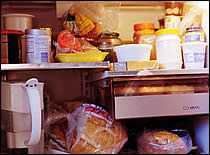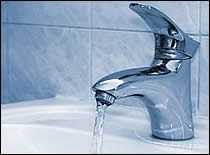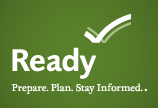Keep Food and Water Safe After a Disaster or Emergency

If you are in a disaster or emergency, it’s important that you take steps to prevent illness from unsafe food and water.
After A Disaster:
Food: Throw away food that may have come in contact with flood or storm water; perishable foods that have not been refrigerated properly due to power outages; and those with an unusual odor, color, or texture. Unsafe food can make you sick even if it looks, smells, and tastes normal. When in doubt, throw it out.
Water: Do not use water you suspect or have been told is contaminated to wash dishes, brush your teeth, wash and prepare food, wash your hands, make ice, or make baby formula. Safe water for drinking, cooking, and personal hygiene includes bottled, boiled, or treated water. Your state, local, or tribal health department can make specific recommendations for boiling or treating water in your area.
Food
Identify and throw away food that may not be safe to eat
Do the following with food and containers that may have had contact with flood or storm water.
 Throw away the following foods:
Throw away the following foods:
- Food that has an unusual odor, color, or texture. When in doubt, throw it out.
- Perishable foods (including meat, poultry, fish, eggs and leftovers) in your refrigerator when the power has been off for 4 hours or more.
- Food not in packages or cans.
- Canned foods or food containers that are bulging, opened, or damaged. Throw away the food if the container spurts liquid or foam when you open it or the food inside is discolored, is moldy, or smells bad.
- Packaged food: Throw away food containers with screw-caps, snap-lids, crimped caps, twist caps, flip tops, and snap-open, and home-canned foods because they cannot be disinfected. Throw away food in cardboard containers, including juice/milk/baby formula boxes.
How to reuse commercially prepared cans and retort pouches (like flexible, shelf-stable juice and seafood packages):
- Remove labels if they are removable.
- Brush or wipe away dirt or silt.
- Wash cans and pouches with soap and water, using hot water if available.
- Rinse cans and pouches with water that is safe for drinking, if available.
- Sanitize cans and pouches in one of two ways. 1.) Place them in a solution of 1 cup (8 oz/240 mL) of unscented household bleach in 5 gallons of water for 15 minutes. OR 2.) Submerge in a pot of water, bring to a boil, and continue boiling for 2 minutes.
- Re-label cans or pouches with a marker. Include the expiration date.
- Use food in reconditioned cans or pouches as soon as possible.
Thawed food that contains ice crystals can be refrozen or cooked. Freezers, if left unopened and full during a power outage, will keep food safe for 48 hours (24 hours if half full).
Store food safely
- While the power is out, keep the refrigerator and freezer doors closed as much as possible.
Feeding infants and young children when your tap water is unsafe
- Breastfed infants should continue breastfeeding. For formula-fed infants, use ready-to-feed formula if possible. If using ready-to-feed formula is not possible, it is best to use bottled water to prepare powdered or concentrated formula when your tap water is unsafe. If bottled water is not available, check with local authorities to learn the status of your drinking water to see if boiling it will make it safe to drink. Use treated water (see water treatment instructions below) to prepare formula only if you do not have bottled or boiled water.
- If water is contaminated with a chemical, boiling it will not remove the chemical or make it safe to consume.
- If you prepare infant formula with boiled water, let the formula cool sufficiently before giving it to an infant. Put a couple drops of formula on the back of your hand to see if it is too hot.
- Clean feeding bottles with bottled, boiled, or treated water before each use. Throw away baby bottle nipples or pacifiers that have been in contact with flood waters; they cannot be sanitized.
- Wash your hands before preparing formula and before feeding an infant. You can use alcohol-based hand sanitizer if water is limited or unsafe.
Clean and sanitize food-contact surfaces that have been flooded
Throw out wooden cutting boards, baby bottle nipples, and pacifiers if they have come into contact with flood waters because they cannot be properly sanitized. Clean and sanitize food-contact surfaces in a four-step process:
- Wash with soap and hot, clean water.
- Rinse with clean water.
- Sanitize by immersing for 1 minute in a solution of 1 cup (8 oz/240 mL) of unscented household chlorine bleach in 5 gallons of clean water.
- Allow to air dry.
Note: Do not use your fireplace for cooking until the chimney has been inspected for cracks and damage. Sparks may escape into your attic through an undetected crack and start a fire.
Related Resources
-
Ask Karen: Chat Online With a USDA Food Safety Expert
Online database of common food safety questions; live chat weekdays 10 a.m.-6 p.m. Eastern Time - USDA Meat and Poultry Hotline: 1-888-MPHotline (1-888-674-6854)
Experts answer questions about food safety, weekdays 10 a.m.-6 p.m. Eastern Time -
Keeping Food Safe During an Emergency [USDA]
General facts on food and water safety, including guidance on when to discard perishable foods -
Food Safety, CDC
Information on food safety and preventing food poisoning -
Personal Hygiene and Handwashing After a Disaster or Emergency
Tips to help protect yourself from illness and disease -
Food and Water Safety and Hand Hygiene Resources
Easy-to-use posters, stickers, flyers, and PSAs with tips and information
Water
Safe drinking water

- After an emergency, especially after flooding, drinking water may not be available or safe to drink.
- Do not use water you suspect or have been told is unsafe to wash dishes, brush teeth, wash and prepare food, make ice, or make baby formula.
- Alcohol dehydrates the body, which increases the need for drinking water.
- Floods and other disasters can damage drinking water wells and lead to aquifer and well contamination. Flood waters can contaminate well water with livestock waste, human sewage, chemicals, and other contaminants which can lead to illness when used for drinking, bathing, and other hygiene activities.
- If your water comes from a private well that has been flooded, consider the following guidance for making water safe and for emergency water sources until you are certain your water is free of contaminants and safe to drink.
Make water safe
Water often can be made safe to drink by boiling, adding disinfectants, or filtering.
IMPORTANT: Water contaminated with fuel or toxic chemicals will not be made safe by boiling or disinfection. Use a different source of water if you know or suspect that water might be contaminated with fuel or toxic chemicals.
Boil water:
If you don’t have safe bottled water, you should boil water to make it safe. Boiling is the surest method to make water safer to drink by killing disease-causing organisms, including viruses, bacteria, and parasites.
You can improve the flat taste of boiled water by pouring it from one clean, disinfected container to another and then allowing it to stand for a few hours, OR by adding a pinch of salt for each quart or liter of boiled water.
If the water is cloudy:
- Filter it through a clean cloth, paper towel, or coffee filter OR allow it to settle.
- Draw off the clear water.
- Bring the clear water to a rolling boil for one minute (at elevations above 6,500 feet, boil for three minutes).
- Let the boiled water cool.
- Store the boiled water in clean sanitized containers with tight covers.
If the water is clear:
- Bring the clear water to a rolling boil for 1 minute (at elevations above 6,500 feet, boil for 3 minutes).
- Let the boiled water cool.
- Store the boiled water in clean, sanitized containers with tight covers.
Disinfectants
If you don’t have clean, safe, bottled water and if boiling is not possible, you often can make water safer to drink by using a disinfectant, such as unscented household chlorine bleach, iodine, or chlorine dioxide tablets. These can kill most harmful organisms, such as viruses and bacteria. However, only chlorine dioxide tablets are effective in controlling more resistant organisms, such as the parasite Cryptosporidium. If the water is contaminated with a chemical, adding a disinfectant will not make it safe to drink.
To disinfect water using bleach:
Bleach comes in different concentrations. Make sure you know the concentration of bleach you are using before using to disinfect drinking water. It should be on the label.
- Clean and disinfect water containers properly before each use. Use containers that are approved for water storage. Do not use containers previously used to store chemicals or other hazardous materials.
- If your water is cloudy, filter water through a clean cloth, paper towel, or coffee filter OR allow it to settle, then draw off the clear water.
When using 5-6% unscented liquid household chlorine bleach:
- Add a little less than 1/8 teaspoon (8 drops or about 0.5 milliliters) for each gallon of clear water (or 2 drops of bleach for each liter or each quart of clear water).
- If you do not have clear water or are not able to filter the water to make it clear, add a little less than ¼ teaspoon (16 drops, or about 1 milliliter) of bleach for each gallon of cloudy water (or 4 drops of bleach for each liter or each quart of cloudy water). Stir the mixture well.
- Let it stand for at least 30 minutes before using.
- Store the disinfected water in clean, disinfected containers with tight covers.
When using 8.25% unscented liquid household chlorine bleach:
- Add a little less than 1/8 teaspoon (6 drops or about 0.5 milliliters) of unscented liquid household chlorine (8.25%) bleach for each gallon of clear water (about 2 drops of bleach for each liter or each quart of clear water).
- If you do not have clear water or are not able to filter the water to make it clear, add 1/8 teaspoon (12 drops, or about 1 milliliter) of bleach for each gallon of cloudy water (or 3 drops of bleach for each liter or each quart of cloudy water).
- Stir the mixture well.
- Let it stand for at least 30 minutes before using.
- Store the disinfected water in clean, sanitized containers with tight covers.
To disinfect water using iodine:
- Follow the manufacturer’s instructions
- Store the disinfected water in clean, sanitized containers with tight covers.
To disinfect water using chlorine dioxide tablets:
- Follow the manufacturer’s instructions.
- Store the disinfected water in clean, disinfected containers with tight covers.
Filters
Many portable water filters can remove disease-causing parasites such as Cryptosporidium and Giardia from drinking water.
- If you are choosing a portable water filter, try to pick one that has a filter pore size small enough to remove both bacteria and parasites. Most portable water filters do not remove bacteria or viruses.
- Carefully read and follow the manufacturer’s instructions for the water filter. After filtering, add a disinfectant such as iodine, chlorine, or chlorine dioxide to the filtered water to kill any viruses and remaining bacteria. For more information about water filters, see the Choosing Home Water Filters and Other Water Treatment Systems page.
Water treatment resources
To learn more about water filters and treatments that can remove organisms such as viruses, bacteria, and parasites (such as Cryptosporidium), see the following resources:
- Making Water Safe in an Emergency
- A Guide to Water Filters
-
A Guide to Drinking Water Treatment and Sanitation for Backcountry and Travel Use
Information on the effectiveness of various water treatment methods - A Guide to Commercially Bottled Water and Other Beverages
- Emergency Disinfection of Drinking Water
Finding emergency water sources
Alternative sources of clean water can be found inside and outside the home. DO NOT DRINK water that has an unusual odor or color, or that you know or suspect might be contaminated with fuel or toxic chemicals; use a different source of water.
The following are possible sources of water:
- Water from your home’s water heater tank (part of your drinking water system, not your home heating system)
- Melted ice cubes made with water that was not contaminated
- Water from your home’s toilet tank (not from the bowl), if it is clear and has not been chemically treated with toilet cleaners such as those that change the color of the water
- Liquid from canned fruit and vegetables
- Water from swimming pools and spas that hasn’t been contaminated with flood or storm water can be used for personal hygiene, cleaning, and related uses, but not for drinking.
Listen to reports from local officials for advice on water precautions in your home.
Outside the home:
Water from sources outside the home must be treated as described in Make Water Safe in an Emergency. These include:
- Rainwater
- Streams, rivers, and other moving bodies of water
- Ponds and lakes
- Natural springs
Unsafe water sources
Never use water from the following sources:
- Radiators
- Hot water boilers (part of your home heating system)
- Water beds (fungicides added to the water and/or chemicals in the vinyl may make water unsafe for use)
Private drinking water wells
Floods and other disasters can damage or contaminate wells. Dug wells, bored wells, and other wells less than 50 feet deep are more likely to be contaminated, even if damage is not apparent.
- After a disaster, it is safest to drink bottled water until you are certain that your water is free of contaminants and safe to drink.
- If extensive flooding has occurred or you suspect that the well may be contaminated, DO NOT drink the water. Use a safe water supply like bottled or treated water.
- Contact your local, state, or tribal health department for specific advice on wells and testing.
IMPORTANT: Fuel and other chemical releases and spills are common during floods.
- Water contaminated with fuel or toxic chemicals will not be made safe by boiling or disinfection. Until you know the water is safe, use bottled water or some other safe supply of water.
- If you suspect your water has fuel or chemical contamination, contact your local health department for specific advice.
For more information: Disinfecting Wells After a Disaster
Related resources
-
Water-related Emergencies and Outbreaks
CDC’s website dedicated to water needs before, during, and after disasters or emergencies -
Drinking Water Wells
Make sure your well water is safe -
Personal Hygiene and Handwashing After a Disaster or Emergency
Tips to help protect yourself from illness and disease -
Food & Water Safety and Hand Hygiene Resources
Easy-to-use posters, flyers, stickers, and PSAs with tips and information -
Cleaning and Sanitizing With Bleach After an Emergency
Information on how to keep surfaces clean to avoid the spread of germs -
Guidelines for the Management of Acute Diarrhea After a Disaster
Acute diarrhea may occur in post-disaster situations where access to electricity, clean water, and sanitary facilities is limited
- Page last reviewed: September 18, 2017
- Page last updated: September 27, 2017
- Content source:


 ShareCompartir
ShareCompartir

